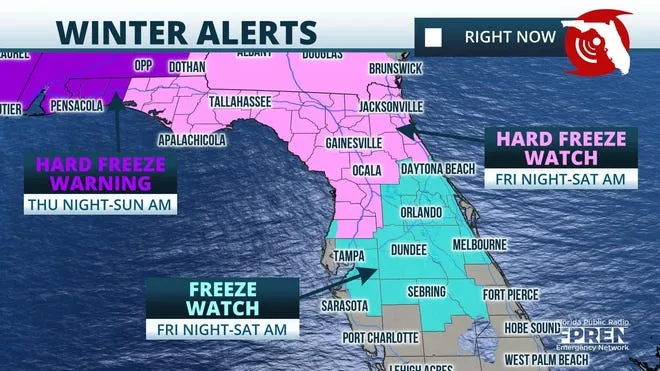Introduction
Florida is widely known for its sunny weather, warm beaches, and tropical climates. However, even this warm state isn’t immune to extreme weather events. One of the most startling occurrences is the Florida freeze warning associated with a polar cold front. These weather phenomena, although rare, bring freezing temperatures and harsh conditions to parts of the Sunshine State, causing potential disruptions to daily life. In this article, we will delve into the phenomenon of the Florida freeze warning and the impact of a polar cold front, including what to expect, how to prepare, and the possible consequences for both residents and the environment.
What is a Florida Freeze Warning?
A Florida freeze warning is issued when temperatures are forecast to dip to 32°F (0°C) or lower for an extended period, typically between 12:00 AM and 9:00 AM. Although freezing temperatures in Florida are not as common as they are in northern states, they still pose significant risks. A freeze warning means that sensitive plants, crops, and even people can be adversely affected by these low temperatures.
Freeze warnings are typically issued by the National Weather Service (NWS), which monitors the weather conditions and forecasts these temperature drops. These warnings are usually associated with the passage of a polar cold front, which can bring much colder air from the Arctic to regions that are typically warmer.
Understanding the Polar Cold Front
A polar cold front is a sharp boundary between cold, dense air from the polar regions and warmer air closer to the Earth’s equator. This front can be highly influential in terms of weather patterns, as it leads to a drastic temperature change over a short period. When a polar cold front moves through an area like Florida, it often results in a sudden drop in temperatures, gusty winds, and clear skies.
Polar cold fronts typically occur in the winter months when the Arctic air mass is strong enough to move southward. While Florida is not a frequent recipient of these fronts, when they do strike, they can bring unusually cold conditions, which lead to the issuance of a freeze warning.
How Polar Cold Fronts Form
Polar cold fronts form when cold, dry air from the Arctic pushes southward due to high-pressure systems. The cold air interacts with the warmer, moist air from the Gulf of Mexico or the Atlantic Ocean, causing rapid cooling and temperature drops. As the cold air moves into a region, it forces the warm air upwards, creating a sharp contrast between the two.
When the cold air dominates and temperatures fall to freezing or below freezing levels, the Florida freeze warning is issued to alert residents to the upcoming risk of frost or freeze. These fronts can move quickly, often catching people off guard if they aren’t prepared.
What to Expect During a Florida Freeze Warning
During a Florida freeze warning triggered by a polar cold front, residents should expect the following conditions:
1. Rapid Temperature Drops
A major characteristic of a polar cold front is its ability to drastically lower temperatures in a short amount of time. Floridians accustomed to warm winter weather may find the sudden change uncomfortable. Temperatures can plunge from 60°F (15°C) or 70°F (21°C) during the day to below freezing levels overnight.
2. Clear Skies and High Winds
After the passage of the polar cold front, skies often clear, and winds can become quite gusty. These high winds, combined with cold temperatures, create a wind chill factor that can make it feel even colder than the actual temperature. Wind chills in Florida can sometimes make it feel like it’s in the teens or even lower.
3. Frost and Freeze Risk
As temperatures fall to freezing levels, frost becomes a significant risk. Sensitive plants, crops, and agricultural fields can be damaged by frost, and homeowners must take precautions to protect their gardens. If temperatures remain below freezing for several hours, a hard freeze could occur, causing more extensive damage to plants and infrastructure.
4. Disruptions to Daily Life
For Florida residents, even brief freezing conditions can disrupt daily activities. Freezing temperatures can cause issues with pipes, vehicles, and outdoor structures. Floridians who are unaccustomed to such conditions may struggle with proper preparation, leading to more significant disruptions during a freeze warning event.
Also Read: Bullock Interactive Launchbox
Potential Risks of a Polar Cold Front in Florida
A polar cold front may not only bring temporary discomfort but also pose real risks to life, property, and the environment. Here are some of the most notable risks associated with these fronts:
1. Damage to Agriculture
Florida is a major agricultural state, and many crops depend on mild, consistent temperatures. A freeze warning linked to a polar cold front can cause significant damage to crops like citrus, strawberries, and other sensitive plants. Freezing temperatures can cause fruit to freeze, ruining entire harvests. Farmers must take protective measures, such as covering crops or using wind machines to prevent crop loss.
2. Pipe Damage and Water Disruptions
Florida homes and businesses are often not built with freezing temperatures in mind. Pipes may not be insulated as thoroughly as those in colder regions. As a result, pipes may freeze and burst, causing significant water damage. Homeowners should take precautions such as insulating outdoor faucets and letting water run at a trickle during freeze events to avoid frozen pipes.
3. Hazardous Driving Conditions
Although snow and ice are rare in Florida, freezing rain and sleet can occur during the passage of a polar cold front. This can create hazardous driving conditions on bridges, overpasses, and elevated roads. Even a light dusting of ice can make roadways slippery, so Floridians must exercise caution while driving during freezing weather.
4. Health Risks
Cold weather can exacerbate preexisting health conditions, especially for the elderly or those with respiratory or cardiovascular issues. Hypothermia and frostbite are risks in any freezing environment, though Florida residents are less likely to have experience with these conditions. People should avoid prolonged exposure to the cold and take care to dress in layers and protect their extremities.
5. Impact on Wildlife
Wildlife in Florida is also affected by sudden cold weather. Some animals, particularly reptiles, rely on the warmth of the sun to regulate their body temperatures. When temperatures drop sharply, these animals may become lethargic or even fall into a temporary state of hibernation. People may encounter fallen iguanas or other cold-blooded animals during these cold snaps, which are usually temporary and harmless.
Preparing for a Florida Freeze Warning
When a Florida freeze warning is issued, it’s important to take several steps to ensure safety and minimize the risks associated with a polar cold front. Here are some key preparations:
1. Protecting Plants and Gardens
Covering plants with blankets, tarps, or special frost cloths can help prevent damage from freezing temperatures. Additionally, watering plants ahead of time can help create a layer of insulation around roots, reducing the risk of freeze damage.
2. Insulating Pipes and Water Systems
To prevent pipes from freezing, ensure that all exposed pipes are insulated. This is especially important for outdoor pipes or those located in unheated areas of the home. Allowing faucets to drip during a freeze can also help keep water flowing and prevent pipe bursts.
3. Winterizing Vehicles
Cold temperatures can affect vehicle performance, so it’s crucial to prepare your vehicle for the cold weather. Ensure that your tires are properly inflated, your windshield wipers are functioning, and your vehicle has adequate antifreeze. If freezing rain or sleet is expected, be sure to leave extra time for driving and clear your vehicle of any ice buildup.
4. Health and Safety Precautions
If you have vulnerable family members, especially the elderly, ensure that they have proper heating and clothing during a freeze event. Make sure that blankets, space heaters, and other warming devices are available if necessary. Avoid staying outside for extended periods, and ensure that everyone is dressed warmly and in layers.
5. Local News and Emergency Alerts
Stay informed by tuning in to local news and weather reports, as well as subscribing to emergency weather alert systems. These resources will provide up-to-date information on the freeze warning, including any changes in weather patterns or emergency procedures that may affect your area.
Conclusion
A Florida freeze warning associated with a polar cold front can be a startling and disruptive event, especially for residents who are unaccustomed to freezing temperatures. While the Sunshine State is generally known for its warm climate, a polar cold front can bring sudden and dramatic temperature drops that pose risks to both people and the environment. By staying informed and preparing in advance, Floridians can minimize the potential impacts of these rare but powerful weather events. Whether it’s protecting crops, insulating pipes, or ensuring that your family stays safe and warm, understanding the nature of a polar cold front and the importance of a Florida freeze warning is essential for navigating these extreme conditions.



